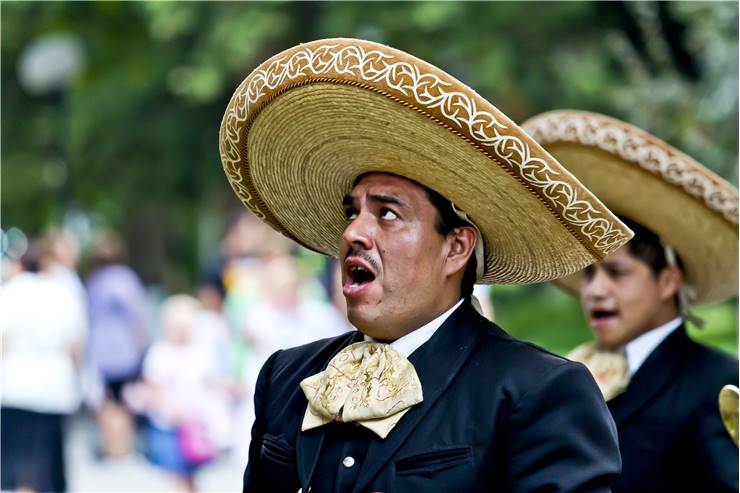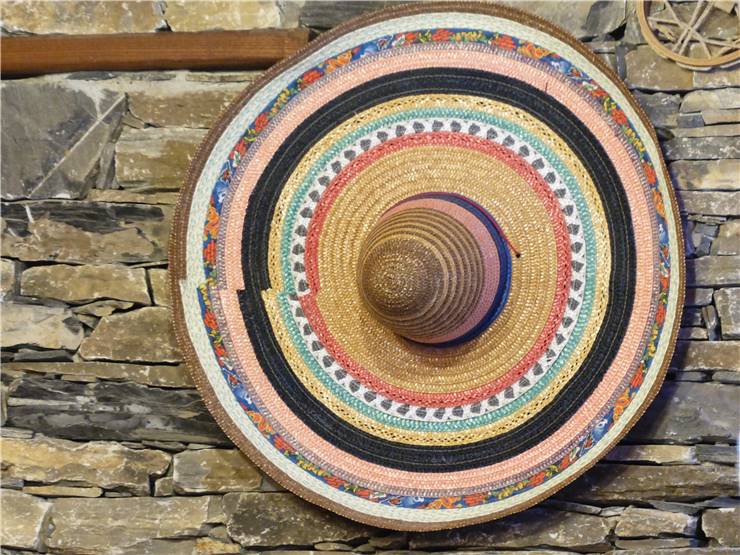Sombrero Hat - History and Types of Sombrero Hats
What is Sombrero hat?
Sombrero is a traditional Mexican hat with a wide brim that is regularly worn by workers, middle and upper-class people, and during celebrations. Created to easily protect the wearer from the strong sun, sombrero hats are distinguished by the extra-wide brims, high and pointed crowns, and in larger hats, a chin strap (borboquejo). Most of the sombrero hats have wide enough brim that can provide shadow not only to head and neck but also to shoulders of the wearer. Traditional sombreros have a brim that is slightly upturned at its edge.
It is important to note that in Mexico, all hats that have wider brim are called with the name sombrero, whether or not the brim is large or upturned.
Why are sombrero hats important?
Sombrero hats were created out of necessity in the early history of the Mexican culture. Faced with the strong sun during an entire year, both native residents of Central America and European immigrants who started settling it during the 17th century and later, quickly strived to find easy ways to provide protection against sun and elements in the territories that were then considered as very desolate, harsh and hard to work in. One of the most popular solutions for protection of the sun were hats imported from Europe, but they were viewed as insufficient against strong Mexican sun, especially for workers who had to stay outside during an entire day. Mexican natives and immigrants soon started building hats with wider and wider brims, and those hats quickly became an iconic clothing accessory for the whole nation.

Sombrero is a famous type of a hat that has managed over the last several centuries to become a part of Mexican culture and the traditions of this country
Word Sombrero – What does it mean?
Sombrero Hat originates from the territory of Mexico where it holds many national and cultural symbols. Word “sombrero” comes from Spanish “sombra” which means “shade” or “ shadow” which explains the main purpose of a Mexican sombrero hat - protection from sun and other natural elements. In Spanish speaking countries outside of Mexico, that kind of sombrero is called “sombrero mexicano” or a “sombrero mejicano” while in Mexico that sombrero is called “sombrero charro”.
Sombrero as a word has a twofold meaning depending on where it is used. In English speaking countries, the sombrero is called a hat with a pointed crown, very wide brim with an upturned edge that is wide enough to cast a shadow overhead, neck and shoulders of the person who wears it, and a strap with which hat is held in place. That kind of sombrero is characteristic of Mexico and Philippines. In Spanish speaking countries, ”sombrero” is a word for any hat with a brim.
Mexican sombrero is a hat worn by mariachi, folk musicians who wear outfits with embroidery, beading and gold threads and have wide sombreros that are decorated similarly and charros, a traditional horseman from Mexico. It is also a part of a “sombrero dance” - jarabe tapatio.
The folk song that accompanies the dance tells about a love story between poor charro peasant and a girl he loves and his attempts woo her. In an attempt to win her sympathies he tosses his sombrero on the ground, the most valuable possession that he has, as a gift and a sigh of his seriousness. When she accepts his advances she starts a dance on the brim of the sombrero.
Sombrero was originally built to be oversized sun protection accessory for outdoor workers, it quickly became a status symbol and a traditional clothing item of entire Central America
History of Sombrero Hat – Who was first?
In modern times, the word sombrero is a synonym of the wide-brimmed Mexican hat, but in reality, its origins can be found in the Spain. Even as far as 17th century, people from this country used to wear hats called “ Sombrero cordobés” (translated as “wide-brimmed hat”), a traditional hat from the Spanish territories of Córdoba and Andalusia. This hat is defined by the flat crown that is between 10-12cm high, and a relatively short and perfectly flat brim that can be 8-12 cm wide.
It is believed that Mexican sombrero was created after Spanish immigrants brought Sombrero cordobés to the New World.
There are different ideas about how sombreros originated in Mexico and who made it. Some think that they are invented by mestizo workers, Latino people of European and Native American descent that were working in the Southern United States and in Mexico. Other think that sombrero was invented by horse riders who came from Jalisco capital, Guadalajara, and who made it part of their uniform. And there are those who think that early cowboys from Texas took the Spanish sombrero as a practical solution for the problem of strong sun.
The Philippines also has a history of using sombreros which came there through Mexican influence by Manila Galleon Trade that was occurring between Manila (now the Philippines) and Acapulco, New Spain (now Mexico) from 1565 to 1815. Zenu Indian tribes of Colombia have their version of sombrero that is made of softer materials and can be folded and put away without fear that it will lose its shape when it is used again.
Ther are several types of wide-brimmed hats for sun protection that were developed around the world well before the first appearance of sombreros in Mexico. For example, Mongolian horse riders wore their traditional wide-brimmed hats as early as 13th century.
Types of Sombrero Hats
In addition to simply providing shade against strong Central American sun, Sombreros can reflect the social and economic status of a wearer. Cheaper sombreros made for peasants are made of straw while more expensive ones are made out of felt. Both can be made in many different colors, designs, patterns, embroidered with golden fibers and other types of decorations. The cheapest sombreros have narrower brim and are created from straw or similar lightweight material that can be used by field workers while they work under the sun. As the hats become more expensive, it usually gets heavier and with the wider brim that better protect against the sun and even enable the wearer to protect their clothes against rain. While a majority of sombreros have a rim that twists upwards at their tips, some smaller variations of this hat can have a perfectly flat rim. This type of sombreros are usually not suitable for use in rainy weather, and the vast majority of them are popular not in Mexico, but in Spain (for example Sombrero cordobés).

The largest sombreros found in Mexico are traditional sombreros, which feature largest brims and are too heavy and impractical to be used by workers. Today, traditional sombreros (many of them with a chin strap called barboquejo) can most commonly be seen being worn by Mariachi, the famous Mexican folk musicians.
Sombrero is one of the largest and best hats for sun protection. It offers brim of sometimes incredible sizes, and it is often made from materials such as straw or felt that can breathe and ease your time in the hot sun.
Modern Sombreros
Today, we can separate sombreros into several types. Here are some of them:
- Quinciano (work/simple outdoor sombrero) - Light, created from straw or other cheaper materials, with small brim size.
- Diechinueve - Higher end version of Quinciano. It is produced from more durable material and with more complicated weave patterns. They are usually custom made for each individual wearer.
- Veintiuno - A better version of Diechinueve sombrero hat.
- Veintisiete - The most high end and complicated sombrero type. It is created from a thickly woven material that allows the user to fold entire hat and put it into a pocket. A single Veintisiete sombrero hat needs around 1 month to be created from scratch.
- Full sombrero - Larger and heavier, usually created from single-colored felt with small and unobtrusive decorations.
- Traditional sombrero - The largest sombrero type, today mostly worn during celebrations or by Mariachi musicians. Even with its extreme size, this sombrero hat is still surprisingly lightweight, but of course, its size makes it impractical for almost any other use.
- Modern, stylish sombrero hats - Modern variations of sombrero hats that are not made from traditional Central American materials. They are usually created for fashionable use by women who want to get protection from the sun on walkways, beaches, and nature.
Sombrero and Poncho as international Mexican Symbols
Even though the sombrero has a long and storied history, modern vision of this hat outside of Mexico is often that of a caricature. Many view it only as a fun accessory, a novelty item, a travel keepsake, and a cheap protection whenever they need to quickly hide from the from strong sun. In addition to it being a simple way to relate to Mexico, the term sombrero has also lost a bit of its meaning in recent times when several other types of hats (such as fedoras or other wide-brimmed hats) started being called sombreros. Native Mexican people oppose this new trend, striving to protect the rich history, heritage and cultural relevance this famous accessory has managed to obtain for itself.
Today, wide-brimmed sombrero and its close cousin poncho (blanket-like outer garment for keeping warm or dry) represent two of the most recognizable clothing accessories of Mexico, Central, and South America . They are today celebrated all across Mexico in several festivals, name-days, traditional music pieces, and dances.


